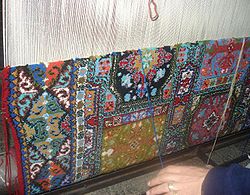
Berber carpet
Encyclopedia


Carpet
A carpet is a textile floor covering consisting of an upper layer of "pile" attached to a backing. The pile is generally either made from wool or a manmade fibre such as polypropylene,nylon or polyester and usually consists of twisted tufts which are often heat-treated to maintain their...
, distinguished by a loop pile construction type, and usually contain small flecks of dark color on lighter shades of background colors. They are typically in a plain color mix with no pattern, and are relatively cheap and durable, so popular for areas with relatively heavy use such as offices. Berber carpets are also the traditional hand-woven carpets of the Berber people
Berber people
Berbers are the indigenous peoples of North Africa west of the Nile Valley. They are continuously distributed from the Atlantic to the Siwa oasis, in Egypt, and from the Mediterranean to the Niger River. Historically they spoke the Berber language or varieties of it, which together form a branch...
of North Africa, which use a distinct knot that gives a similar appearance to a modern Berber carpet, but are brightly colored with designs that are different from other oriental rug
Oriental rug
An authentic oriental rug is a handmade carpet that is either knotted with pile or woven without pile.By definition - Oriental rugs are rugs that come from the orient...
s.
History
The origin of Berber carpets date back to the PaleolithicPaleolithic
The Paleolithic Age, Era or Period, is a prehistoric period of human history distinguished by the development of the most primitive stone tools discovered , and covers roughly 99% of human technological prehistory...
era and were made by Berbers
Berber people
Berbers are the indigenous peoples of North Africa west of the Nile Valley. They are continuously distributed from the Atlantic to the Siwa oasis, in Egypt, and from the Mediterranean to the Niger River. Historically they spoke the Berber language or varieties of it, which together form a branch...
in North Africa
North Africa
North Africa or Northern Africa is the northernmost region of the African continent, linked by the Sahara to Sub-Saharan Africa. Geopolitically, the United Nations definition of Northern Africa includes eight countries or territories; Algeria, Egypt, Libya, Morocco, South Sudan, Sudan, Tunisia, and...
. The hand spun cloth they created was named for the tribe, and they used natural fibers to create cloaks, rugs, and other fabrics.
Traditional Berber carpet
Handmade / homemade Berber carpets are still an active industry in many rural areas of MoroccoMorocco
Morocco , officially the Kingdom of Morocco , is a country located in North Africa. It has a population of more than 32 million and an area of 710,850 km², and also primarily administers the disputed region of the Western Sahara...
and other North African countries. Many Berber families gain their daily bread from manufacturing carpets manually and selling them in local markets or even to art merchants and tourists. Traditional Berber carpet is totally different from the modern mass produced berber carpets usually known in the West. They are much more sophisticated and are made of natural materials.
Modern Berber carpet
Today there are several types of modern Berber carpet made from a range of materials. NylonNylon
Nylon is a generic designation for a family of synthetic polymers known generically as polyamides, first produced on February 28, 1935, by Wallace Carothers at DuPont's research facility at the DuPont Experimental Station...
, Olefin fiber
Olefin fiber
Olefin fiber is a synthetic fiber made from a polyolefin, such as polypropylene or polyethylene. It is used in wallpaper, ropes, and vehicle interiors....
, and wool
Wool
Wool is the textile fiber obtained from sheep and certain other animals, including cashmere from goats, mohair from goats, qiviut from muskoxen, vicuña, alpaca, camel from animals in the camel family, and angora from rabbits....
are the most common materials, and the size of loops and cut pile varies for each manufacturer. Olefin is the most commonly used and most affordable material, and carpets with blends of the different materials are also available.
Berber carpet is highly durable and is often found in offices, schools, and other high traffic areas. It is stain resistant as well, and is more affordable than thicker plush carpets. The downside is that it can be difficult to clean if dirt does get lodged in the fibers, and it may need dry cleaning or specialized service for deep cleaning. It is recommended by most professionals that Olefin Berber be cleaned using a low-moisture or dry cleaning process. Traditional Steam cleaning with high alkaline detergents can cause potential pH burns in the olefin. These appear as large yellow or brown splotches. Yellow or brown spots also may be tannin bleed from the sugars in natural fiber carpets that are drawn to the top by improper drying usually caused by over wetting. There are carpet chemicals that can eliminate most of this yellowing or browning but they are very expensive, and it would be better to not get the yellowing or browning. A better, but more difficult, method may be to dry the carpet from the bottom. This method usually would entail pulling up some of the carpet to install a carpet fan under the carpet, and using hot air, not just room temperature air. Regrettably, many of these stains can be permanent if not corrected quickly by a professional carpet cleaner. As with all carpets, Berber should be cleaned every 6 to 12 months to prevent permanent wear patterns.

